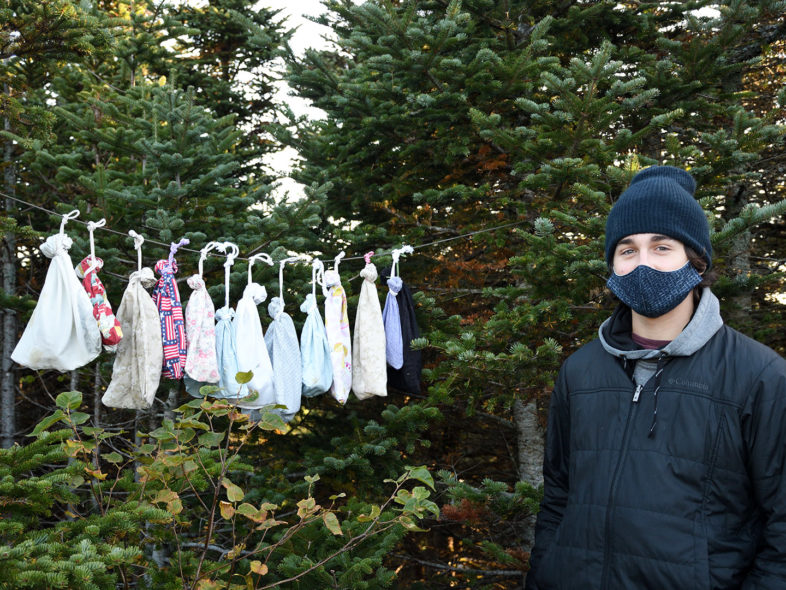
Avery Fish with a bounty of netted birds awaiting processing on the VCE avian “clothesline”, Mt. Mansfield, 18 September 2020. © Michael Sargent
VCE’s 2020 wrap-up banding session on Mt. Mansfield—our tenth visit of the season—may have been our most memorable. It yielded an impressive diversity of birds, including our first-ever Western Palm Warbler and a truly venerable 10 year-old Bicknell’s Thrush. Our annual mid-September visit to VCE’s long-term ridgeline study site has become a rite of passage, as we witness the resurgence of activity by Bicknell’s Thrush (BITH) just before the species’ southward departure and intercept an eclectic mix of transients. This year did not disappoint.
Our team of 7 arrived in late afternoon on 17 September to clear skies, light winds and cool temperatures—perfect netting conditions. We quickly set up our 23 mist nets and had our first capture at 6:00 pm, a hatching-year (HY) BITH. We netted another 9 birds before darkness settled in two hours later. Three of these were BITH, including 2 males we had banded back in June; all had completed their post-breeding molt and are now accumulating energy reserves that will propel them to their Greater Antillean wintering grounds (Hispaniola, Cuba, Jamaica, and Puerto Rico). The third BITH carried a decidedly worn, dull metal band #2341-24095, our first clue that it was an old-timer. A check of our records revealed an astonishing fact—we had banded the bird as a yearling male on 9 June 2011, making it the second oldest BITH known to science at age 10+! Following its initial 2011 capture in our Lakeview 2 net (precisely where we caught it on 9/17/20), we captured #2341-24095 18 additional times times between 2012-2017, at least once each summer (and once in September). However, we missed it in 2018, 2019, and nearly in 2020, suggesting a recent shift of breeding home range just outside our main netting area. Reflecting on the ~1800-mile (2900-km) one-way migration distance between Mt. Mansfield and the southern Dominican Republic—and the roughly 36,000 round-trip miles that this remarkable bird has navigated over its decade of life (with precise orientation back to Mansfield each year!)—we had to wonder, as we watched #2341-24095 disappear back into the montane forest, if we’d see him again in 2021.
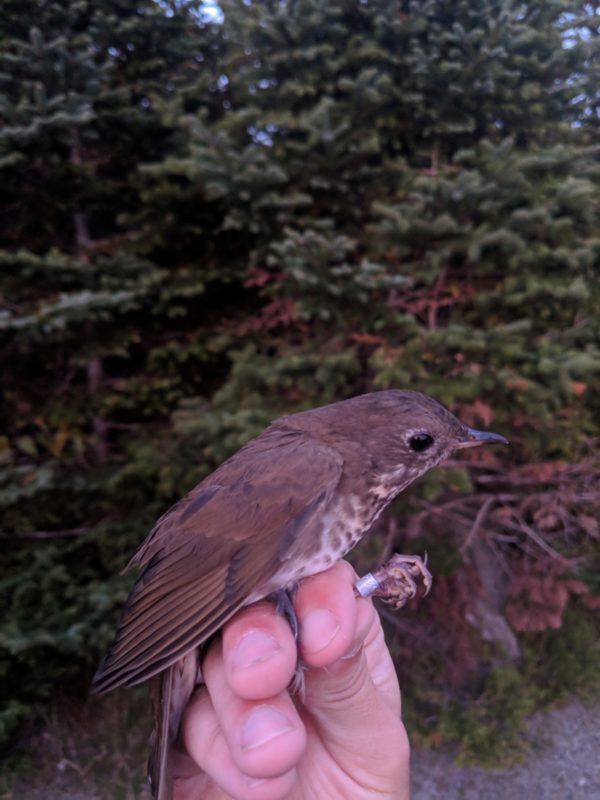
BITH #2341-24095, a true veteran at 10+ years old, was banded as a yearling on 9 June 2011, recaptured at least once each summer from 2012-2017, eluded VCE’s nets in 2018 and 2019, then reappeared on 18 September 2020 in the exact location (Lakeview 2 net) of its original capture. The bird’s dull, worn leg band signals its remarkable longevity. © Nathaniel Sharp
Exhilarated by our encounter with this battle-tested veteran BITH, we closed our nets and prepared for a chilly night under the stars. The senior member of our team made a rude discovery when unpacking his gear, realizing that he had neglected to bring a sleeping bag. Suffice it to say that a long, mostly uncomfortable night ensued, with every possible layer of clothing employed, and a new footwarming technique adopted—bird bags! I placed no fewer than 4 cloth bird bags on each of my double-stockinged feet, climbed into my 1-person tent, and…dozed, fitfully. Morning couldn’t come quickly enough.
With daylength much reduced from June and July, the team slept in (well, those who managed some sleep) until 5:00 am, opening nets in pitch darkness with a temperature of 30F and frost coating the ground. No Northern Saw-whet Owls materialized, as they had in July, but mist net captures were steady through the morning. Conditions remained calm, and a warming sun pushed ridgeline temps into the mid-40s. Despite the lack of a dramatic fall out, we had a nice mix of local breeders and migrants, ending up with 19 species. Highlights were many and included our first-ever (and overdue) Palm Warbler (Western subspecies), a Lincoln’s Sparrow, a Bay-breasted Warbler, and a HY male Sharp-shinned Hawk (our 4th of the season, an all-time record). Kinglets and creepers unexpectedly outnumbered Blackpolls and Yellow-rumpeds.
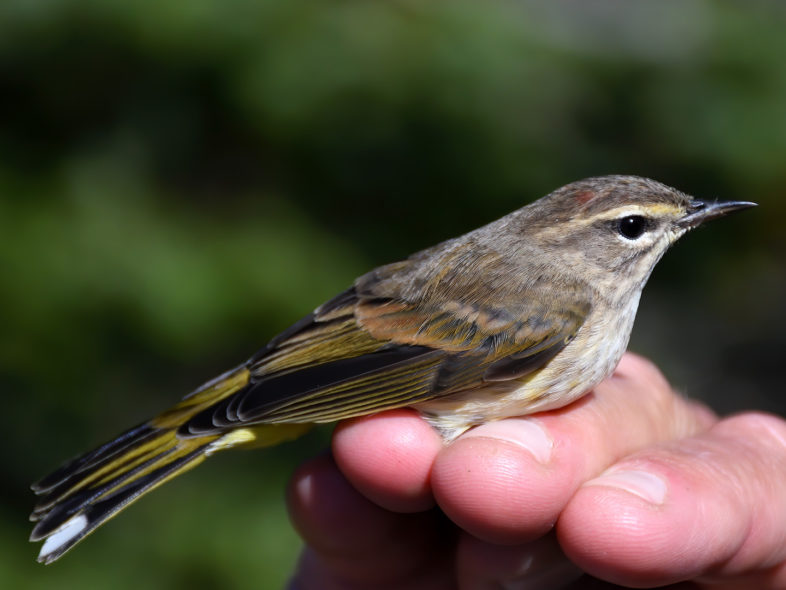
A Western Palm Warbler—long overdue on Mt. Mansfield—VCE’s first record of this (sub)species in 29 years of banding, 18 September 2020. © Michael Sargent
Our final tally of 72 birds included:
Sharp-shinned Hawk — 1 HY male (our record 4th of the season)
Blue-headed Vireo — 1 HY
Blue Jay — 1 HY
Golden-crowned Kinglet — 9 HY
Ruby-crowned Kinglet — 3 HY
Brown Creeper — 3 HY
Bicknell’s Thrush — 10: 5 new (3 HY, 2 AHY), 3 recaptures of adult males banded in June, 1 return male banded in June 2018 and not recaptured since, 1 return male banded as a yearling in June 2011 (now 10 years old!)
Swainson’s Thrush — 5 new (3 HY, 2 AHY)
Dark-eyed Junco (Slate-colored) — 2 1 HY, 1 recapture of an adult male banded in June
White-throated Sparrow — 14 new (13 HY, 1 AHY)
Lincoln’s Sparrow — 1 HY
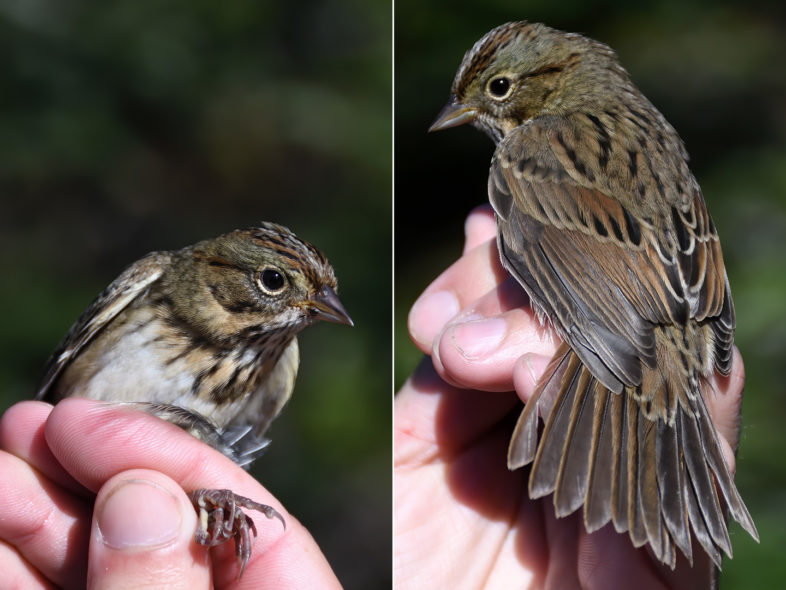
A rarely encountered migrant Lincoln’s Sparrow on Mt. Mansfield, 18 September 2020. © Michael Sargent
Ovenbird — 1 HY
Nashville Warbler — 2 HY
Bay-breasted Warbler — 1 HY male
Blackpoll Warbler — 9 new (6 HY, 3 AHY)

Quintessential confusing fall warblers that pose an ID challenge for any birder: a HY male Bay-breasted Warbler (left) and a HY Blackpoll Warbler (right). A hint of rufous on the male Bay-breasted’s flanks makes for a much easier separation from Blackpoll than is often possible! © Michael Sargent (left), Charles Gangas (right)
Black-throated Blue Warbler — 3 HY
Palm Warbler (Western) — 1 HY
Yellow-rumped Warbler (Myrtle) — 4 HY
Black-throated Green Warbler — 1 HY
Overall, 2020 was a solid banding season on Mansfield, albeit with some logistical twists (e.g., early toll road closure, off-limits buildings, COVID restrictions). Final tallies await, but we processed ~525 captures, nearly 100 more than during each of the three previous seasons. Notably, numbers of two focal montane forest specialists—BITH and Blackpoll Warbler—showed solid increases. We captured 40 BITH, of which 35 were known-sex adults (25 males and 10 females, reinforcing our consistent finding of a highly male-biased adult sex ratio). Fully 16 (46%) of these—12 males and 4 females—were banded birds from previous years, with 5 banded in 2016 or earlier—this is one site-faithful, long-lived songbird! Blackpolls experienced a strong increase, with 52 captures (31 in 2019) of known-sex adults (30 males, 22 females), of which 7 were returnees, 6 from 2018 and 1 from 2019.
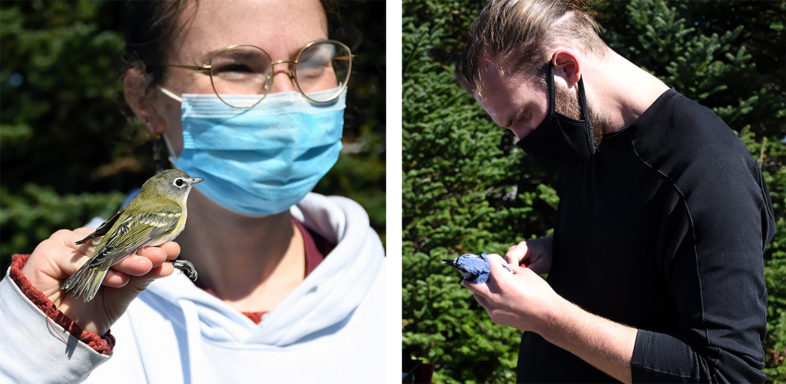
VCE EcoAmericorps members pitch in with Mansfield banding: Julia Pupko (left) with a Blue-headed Vireo, Pete Kerby-Miller (right) with a Blue Jay. 18 September 2020. © Michael Sargent
As always, our Mansfield field season was as rewarding for the human connections it provided as for the avian encounters. Although COVID-19 precluded the usual (and welcome) stream of visitors to our ridgeline study site—birders, families, students, conservation partners, supporters, and friends—we managed to have a few stalwart souls join us each week. These hardy folks enthusiastically pitched in with setting and taking down mist nets, banding birds, recording data, asking insightful questions, and keeping us all in good humor. They also survived some chilly nights under the stars and posed dutifully for Mike Sargent’s outstanding shots of hand-released birds. We can’t thank each and every one, but a special shout-out goes to our handful of 2020 “regulars”: Chris Hansen (our banding ace-in-the-hole), Avery Fish (recorder extraordinaire), VCE’s own Spencer Hardy, and our photographic whiz Mike Sargent. We look forward to welcoming many more visitors during 2021, which will mark our 30th field season on the mountain.

Thank you for some cheery news in this difficult time.
Thanks for all the news from the top of Vermont. Another exciting season.
Great report. Thx for sharing.
What does AHY indicate?
Mike — AHY signifies after hatching-year, which in banding terminology means a bird that is banded or captured in a calendar year subsequent to the one in which it was banded. So an AHY bird now was hatched in 2019 or earlier.
Congrats. Chris. on what appears to have been a (steller) year.
Thank you for all you do for bird conservation and may next year be just as steller as this year was!
Thanks to all for the stories & especially pictures. Birds are a joy in these challenging times.
Thanks for the good news. As others have said, really nice to read something uplifting. Love the photos too.
The second oldest BITH know to science in your mist net? Now that is something to make you smile. Thanks for all the hard and important work done on Mt. Mansfield year after year…..and next time remember your sleeping bag!
OK…the COVID wall came up this summer – but hopefully not next summer! Hope to see you then and there…
I’m a total newbie here, so please excuse what may be a naive question – what is in those hanging bags? Dead birds? Why are they dead? Did they get caught in the netting you mentioned? Why is there netting? And if the birds are alive, why would you leave them in bags which must be terrifying – or are they asleep?
Hello Gigi — each bag contains a very much alive and unharmed bird, which we process individually, efficiently and safely before releasing them back into the wild. The entire process takes 2-3 minutes and does not cause undue stress–and certainly no physical harm–to the birds. I hope you can sense from the handheld photos that the birds are not terribly agitated and are being handled expertly. We check our nets at least once per hour, so the birds are not entangled for long (and the nets do not harm them either). The bags are cotton and so very breathable. The netting is done as a means to sample the local (or migrant) bird population. It not only allows us to obtain an “index” of the local population on Mt. Mansfield’s ridgeline each summer , but to mark each bird with a unique metal leg band, which permanently identifies it. That then allows us to learn a great deal about each species’ population dynamics and ecology, in ways that we could never do otherwise. For example, we’d never have known that Bicknell’s Thrush can live to the ripe old age of 10 years without banding them. Bird banding in the U.S. is regulated by the USGS Bird Banding Lab (a license is necessary), and you might find this web page informative: https://www.usgs.gov/centers/pwrc/science/why-do-we-band-birds?qt-science_center_objects=0#qt-science_center_objects. Please feel free to contact me directly at <> if you’d like to learn more.
Best event of the early Fall! The humans and the birds are extraordinary! Many thanks to ALL of you!
Man I miss working on the Mount Mansfield Chasing the birds!